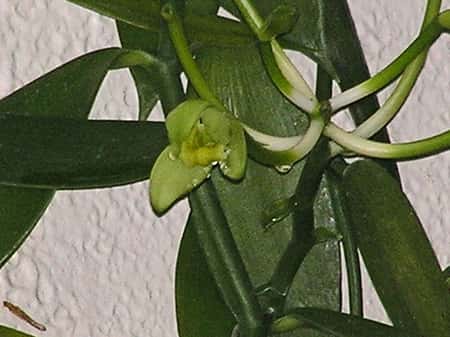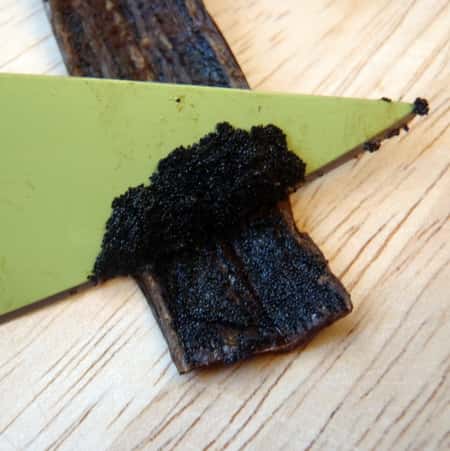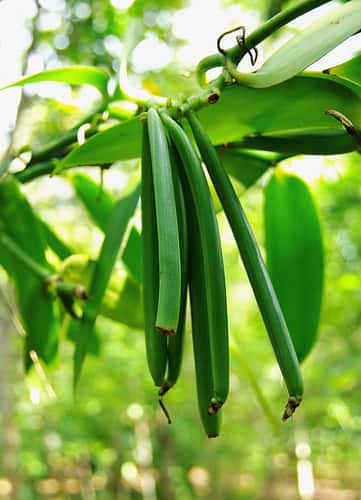Vanilla is used for everyday cooking since long before we have documented. The first time recorded in history was when the Spanish discovered the Vanilla orchid (Vanilla planifolia) being produced by the Aztecs.
Vanilla orchids aren’t exactly beginner friendly, since the humidity, light and high watering demands are all high.
To learn how to grow vanilla orchids indoors, you’ll need lots of light, an average humidity of 80%, temperatures around 80 to 95 F (26 to 35 C) during the day, and lots of air movement. Vanilla orchids like to grow mounted on trees or anything they can climb, so having a moss post helps when growing these orchids indoors.
Vanilla comes from the Spanish term “a little pod.” From Mexico, the popularity of Vanilla grew world-wide, conquering our hearts and taste buds.
Vanilla is used in modern-day cooking to add flavor to coffee, chocolate, cookies, cakes—all the good stuff in life starts with c—and almost every sweet recipe you can name.

by 阿橋花譜 KHQ Flower Guide is licensed under CC BY-SA 2.0

Vanilla, surprisingly or not, is an orchid.
Many people think that it’s the only edible orchid, but that’s off tune.
In Turkey, they make ice cream with orchids. There are many other orchid delicacies that your can add to your menu if you look past your everyday menu items. If orchid cuisine is something that interests you, here’s a Thai recipe and an article about edible orchids.Vanilla is not the only edible orchid, but it is the most commonly known one. Contrary to most orchid—well, the ones that I write about—the Vanilla orchid doesn’t start off as an epiphyte (growing to trees.)
The Vanilla plant needs soils and the nutrients in the soil to produce the initial growth, which then climbs up the tree trunks where it lives until maturity.
Once established in trees, they can grow from 20 to 30 feet (9 meters) high, securely wrapping themselves around the trunks. In nature, they can grow 300 feet, but greenhouse growth is limiting. Areal roots will replace the terrestrial ones, capturing the nutrients from the air currents and humidity.
What Part of the Vanilla Orchid is Edible?
It’s not the flower. It’s the seed. I ‘ve no idea who first decided to make vanilla, yet how they even imagined or dreamed up such a process… They must have a very active imagination and a lot of time on their hands.
The seeds, found as they are, resting quietly inside their green-bean shaped pods, do not taste like anything. Actually, to make vanilla, you’re in for a long process which will only show signs after three years.
To get the beans, you’ll need to wait until the plant is producing seed pods that are at least six inches long. Remove the pod with the seeds still inside, which will grow from October to March. Every night, you’ll need to cover these pods in a protective covering to make them sweat. Well, they’re actually producing humidity and fermenting, but my “non-techy” side sees it as sweating.
The humidity gets trapped inside the pod and slowly softens the seeds while fermenting it. In the morning, take the pods out to bright sun and have nature bake them until evening. You can use heat lamps to achieve this as well. Do this for six long, exhaustive weeks.
When the bean pod is shriveled up, dark brown, and has been knocking on heaven’s gates for quite a while, you’re still not done.
Now they need to sit for a while in a dark, quiet place and meditate about all the suffering they’ve been through.

Basically, they’re searching for the meaning of life.
Only after three months of intense soul-searching, your vanilla seeds are ready to be consumed.
Make a slit down the center of the pod and CAREFULLY, extract the tiny seeds. This process explains why vanilla is so expensive compared to other spices.
How do I Grow a Vanilla Orchid at Home?
First, you’ll need to recreate the exact environment the orchid grows in. As for the Vanilla, it will be a little more challenging than for other orchids, which are best recommended for initial orchid hobbyists.
Most all naturally grown Vanilla cultivators are located in Mexico, Florida, and Madagascar. In Central and South America along with the West Indies, vanilla can be grown if the humidity is high enough.
Orchids love water and humidity. You’ll need to water them constantly and still provide relative air humidity in the environment. All four varieties of vanilla love extremely high humidity, averaging 80%. This isn’t the maximum, it’s the average. Recreating a vanilla orchid environment inside your house is doable, but will take extreme work.

A humidifier is absolutely necessary.
If you want more information on humidifiers, check out this article, which is the by-product of evaluating and analyzing over one thousand reviews about the best humidifiers on the market.
The temperatures in these tropical climates is always high.
You’ll need to keep the heat cranked up to the maximum in the day, anywhere from 80 to 95ºF. At night, you can get away with 60 to 70ºF. Actually, the drop in temperature does wonders for the orchid.
If you do only these two, temperature and humidity, then your growing environment will turn into a fungal party. With such high humidity, the fan will need to keep running. Air circulation maintains the roots dry and the leaves free of water droplets, so keep the fan on high. A low setting on the fan won’t dry up the roots as much as they’d like.
As for lighting, vanilla orchids aren’t that fussy. If you grow other orchids at home, your Vanilla will be just fine. Just keep them out of direct sunlight. Vanilla Orchids are intermediate light orchids, preferring bright shade.
The Right Potting Mix
Orchids are terrestrial in the beginning. Don’t make the mistake of potting them in pure sphagnum moss, thinking that they only want humidity. They’ll love the humidity, but won’t have any nutrients.
You’ll need to add part soil to the medium when you get a new plant.
Once the plant has grown and has some vines that are crawling upward and some areal roots, you can change the potting medium to bark and sphagnum. Many people use coconut husks and coco chips, which work just as well. Just don’t make it too damp.
At this point, the potting medium isn’t as important as the pole that the vanilla orchid is going to climb. It needs to be covered in moss (mainly because 80% humidity is extremely hard to achieve without extra help.)
The flowers of Vanilla orchids aren’t the plant’s main attraction, but they are quite pretty. Nothing like a cattleya, in my opinion, but everyone has their own taste. Vanilla flowers are a pale yellowish-green color, 5 to 7 cm long.
If you want a vanilla flower that’s absolutely gorgeous, keep reading below.*
Anyway, the pole must be securely fastened with moss and tied down with either wire or floral wire. The nodal roots will attach to the pole, as it scrambles up the moss-covered spike.
If you want a trellis-look with delicate lattice—don’t. Just don’t. A flimsy spike will fall over and with the weight of this adult plant, it will not hold up. When the vanilla plant reaches adulthood, it can be as long as 30 feet.
Once the orchid has reached the top of the support that it climbs on, it will start to dangle. This is one internal signal that the orchid will produce flowers. An orchid that is still climbing will not flower, so resist the urge to fixate the dangling twines into the sphagnum pole.

Where to Buy Vanilla Orchids?
If you are looking to buy Vanilla orchids to make vanilla, make sure you get the Vanilla Planifolia, since these are the commercially grown vanilla seeds. There are four other types of most common types of vanilla: Aphylla, Phalaenopsis, Polyepsis and Pompona. The uncommon list is quite long…
If you’re not into the vanilla seed fermentation process but want a beautiful vanilla flower, my oh my… get the Vanilla Phalaenopsis, or Vanilla Roscheri. Absolutely stunning. The flowers on these East African babies are 35cm long and 15 cm across. They are white, but in the middle near the throat, the colors softly mix and combine a soft cream of delicate apricots, peaches, pinks, and salmons.
As for store names, I don’t recommend orchid sellers, for the sole fact that I don’t know what shipping and handling to your specific location would be like. I know where I buy mine, but if I haven’t tested a store, I can’t recommend it.
What if a store did a great job shipping to me, but when it comes to your location, they mess up? That’s my name behind the recommendation. But if you know a store and would like to leave the name in the comments, please do.
What I can say, is that is one vanilla Orchid can be bought online for around US$ 20.00. After three years of growing this orchid properly, you can have hundreds of pods in one season.
On the lucrative side: One vanilla bean pod can be sold for US 2.00 to US$ 9.00. So if you have the right growing conditions and patience, it’s definitely worth a try.
Don’t Stop Learning!
If you want to be included in more information and get a 14-page fertilization guide, please sign up for my newsletter. I don’t spam, but send emails out bi-monthly with some curious topics of interest. If you want more information, click here to go to a specific page on this website where I explain it more in detail.

Also, if you are looking for an orchid journal to keep your notes specifically about orchid care, check out my 2 solutions for that on this page. If note-keeping isn’t your thing, then there is a free excel spreadsheet that you can download. Click here for more information on how to do that.
If you subscribe to my newsletter, I will send you a 14-page guide on the main tips of orchid fertilizer. It is downloadable and you can print it out on your computer. I designed the guide to double up as a coloring book, just to make it fun.
Wishing you the best with your Vanilla Orchid! Happy Cultivating!

